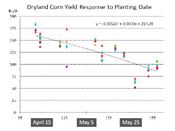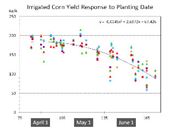When Is The Cut-Off Date For Planting Corn?
DR. ERICK LARSON
MISSISSIPPI STATE, MISSISSIPPI
Persistent rains have limited corn planting progress across much of Mississippi once again this spring. It is well known that corn is normally more productive when planted early, primarily because its’ sensitive reproductive development will occur earlier in the summer when environmental conditions are normally more favorable. However, as with most cropping decisions, planting date is not the only variable affecting profitability. For example, the highest yielding corn in the NCGA Yield Contest grown Mississippi during last two years was planted in May. Therefore, several factors determine crop outcome and influence decisions regarding planting corn or changing crop intentions.
Environmental conditions during the spring can dramatically affect corn seedling establishment and ultimately stand quality. Corn is very sensitive to stand quality because it has little physiological ability to compensate for seedling mortality or plant growth disparity, compared to other crops. Accordingly, early corn plantings may fail to realize their potential if adverse weather hampers seedling health, and often promote other issues, such as soil compaction, which restrict growth throughout the season. Corn planted when soil is warm and dry later in the spring typically has much better chance of achieving a uniform, vigorous stand of healthy plants.
I am sure many are wondering whether to continue planting corn, or whether planting delay may dictate a change of crop intentions.
Fortunately, we have a strong research database produced at Mississippi State University to help answer this question. This research showed corn yield declined as planting was delayed, as anticipated. Corn response to planting date varied considerably depending upon whether corn is grown with supplemental irrigation, as opposed to a dryland environment – where moisture supply is dependent upon rainfall.
The key findings include:
• Irrigation can relieve mid-season water stress and thus extend opportunities for optimal corn yield until later planting dates, compared to dryland fields. In fact, irrigated corn productivity does not begin to appreciably decline until about May 1 at a Highway 82 latitude. Consequently, irrigated corn grown in northernmost Mississippi counties likely would not see corn yields begin to decline until around May 10.
• Corn grown in dryland conditions is more vulnerable to yield loss associated with delayed planting, as opposed to irrigated fields.
• Additionally, the rate of corn yield loss relative to planting delay in Mississippi is similar to corn grown throughout the Corn Belt. Thus, there is little justification to hastily cut-off or terminate corn planting until well beyond optimal dates.
Irrigated corn planting date field studies were conducted in 2009, 2010 and 2011 at the MSU Delta Research and Extension Center at Stoneville and the RR Foil Plant Science Research Center at Mississippi State University using furrow irrigation. Corn produced optimal grain yields until about May 1, when productivity began to fall. Corn yield loss was relatively moderate through May and declined more substantially in June. The magnitude of irrigated corn yield reduction associated with planting beyond the optimum time frame was 1.3 bu. per day or 0.76 percent per day for plantings during May and increased to 2.1 bu. per day or 1.59 percent per day for June plantings. The numbers on the X-axis in the figures below represent the Julian date of the year (75 = March 16, 165 = June 14). The trendline shows the yield response of five hybrids (each represented by a different color) planted at 2 to 2 ½ week intervals over the duration of the study.
Dryland studies were conducted at the RR Foil Plant Science Research Center at Mississippi State University in 2010, 2011 and 2012. Corn planted at later dates grown in dryland culture suffered more consistent yield loss than irrigated corn. However, pollination failure or catastrophic yield loss never occurred, despite corn being exposed to two of the most severe drought seasons in Mississippi history during 2010 and 2011. The magnitude of dryland corn yield reduction was 1.3 bu. per day or 0.83 percent per day for plantings after Mid-April. Although substantial, this yield loss was relatively moderate and not substantially different from Corn Belt studies. The numbers on the X-axis in the figure below represent the Julian date of the year (95 = April 5, 155 = June 4). The trendline shows the response of five hybrids (each represented by a different color) planted at 2 to 2 ½ week intervals over the duration of the study. ∆
DR. ERICK LARSON: State Extension Specialist, Mississippi State

